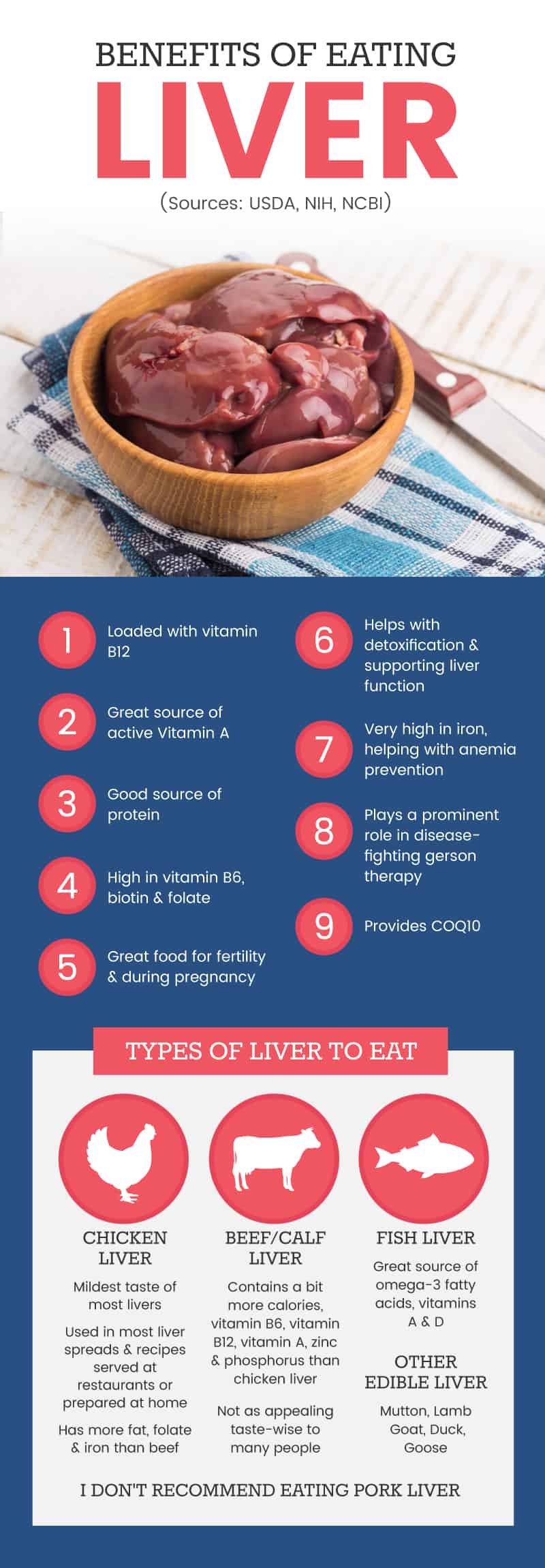
One of the questions people ask often is, “Is liver good for you?” Organ meats, including liver, are considered one of nature’s most powerful superfoods.
That’s because chicken, duck and beef liver are very high in many essential nutrients, in some cases even more so than plants like leafy greens and berries. In fact, ounce for ounce, liver is probably more nutritious than any other food.
Also called offal, organ meats have been included in traditional diets for thousands of years, such as in the form of liver and onions. Packed with vitamin A, iron, B vitamins, protein and much more, liver may help prevent anemia, support fertility, aid in detoxification and prevent certain nutrient deficiencies.
What Is Liver? (Plus Types to Eat)
Liver is an organ found in the abdominal cavity of both humans and many animals, specifically all vertebrates. Chicken and beef liver are the two most widely available types in many countries.
Throughout history, people living all over the world have highly regarded organ meats for helping with fertility, growth and development; maintaining high energy levels; supporting mental health; and more.
In Traditional Chinese Medicine, liver has long been viewed as a nutrient-providing powerhouse. Eating organ meats is believed to help replenish depleted nutrition stores and support the functions of one’s own organs.
For many centuries, liver has been eaten by hunter-gatherers, such as those living in parts of Africa, who subsided on mostly animals like moose and deer. This superfood was a valuable source of protein and nutrients when food was scarce, including in colder climates when plant foods were hard to grow.
In Medieval Europe, liver was a popular ingredient used in dumplings, terrines, sausages and puddings. In Asia, it has a long history of use in broths and stews and is sometimes used to thicken recipes.
In Japan, it has always been considered an important food for pregnant women. Today, it’s still commonly consumed in France, Argentina, India, Spain, Russia, parts of Scandinavia and parts of the Middle East.
Types:
- Chicken liver — Chicken liver has the mildest taste of most livers, so it’s a good choice for organ meat “beginners.” It’s the type found in most pates and spreads served at restaurants or prepared at home. It has more fat, folate and iron than beef liver.
- Beef/calf liver — Beef liver contains a bit more calories, vitamin B12, vitamin B6, vitamin A, zinc and phosphorus compared to other types. Many people find that it doesn’t quite taste as appealing as chicken liver. You can find it at some farmers markets, but if possible it’s best to purchase calf liver since this reduces the chance that you’ll consume hormones and antibiotics given to cows.
- Fish liver (such as cod liver or cod liver oil) — This is a great source of omega-3 fatty acids, vitamin A and vitamin D.
- If you can find them, you can also try mutton, lamb, goat, duck or goose livers. These provide healthy fats, including omega-3s and other polyunsaturated fats. Your best bet for finding these types of is asking your local butcher, or if you’re a hunter, you can gather and prepare them yourself.
- I don’t, however, recommend eating pork liver, due to how pork products tend to come from unhealthy/dirty pigs. Pigs typically are raised in factory-farm conditions and treated with hormones or other chemicals.
Related: What Is Tripe Meat? 4 Reasons to Eat This Offal
Nutrition Facts
If you compare the overall nutrient density of liver to other healthy foods like spinach, carrots or apples, liver actually outperforms all of them due to how many vitamins and minerals it packs per calorie.
Is liver healthier than meat? Compared to a serving of beef, a serving of organ meat is higher in certain nutrients. As a very nutrient-dense food, liver is a great source of vitamin A, iron, B vitamins and more.
In fact, liver is hands down your greatest source of vitamin B12. Research shows it’s also one of the top contributors of copper, zinc, phosphorous and magnesium in some people’s diets.
Liver from different animal sources provides varying levels of micronutrients. According to the U.S. Department of Agriculture, one ounce (approximately 28 grams) of cooked chicken liver contains about:
- 46.8 calories
- 0.2 grams carbohydrates
- 6.8 grams protein
- 1.8 grams fat
- 4.7 micrograms vitamin B12 (79 percent DV)
- 3,732 international units vitamin A (75 percent DV)
- 162 micrograms folate (40 percent DV)
- 0.6 milligrams riboflavin (33 percent DV)
- 23.1 micrograms selenium (33 percent DV)
- 1.9 milligrams pantothenic acid (19 percent DV)
- 3.3 milligrams iron (18 percent DV)
- 3.1 milligrams niacin (15 percent DV)
- 7.8 milligrams vitamin C (13 percent DV)
- 0.2 milligrams vitamin B6 (11 percent DV)
- 113 milligrams phosphorus (11 percent DV)
- 1.1 milligrams zinc (7 percent DV)
- 0.1 milligrams copper (7 percent DV)
- 0.1 milligrams thiamine (5 percent DV)
- 0.1 milligrams manganese (5 percent DV)
Are you curious about whether liver is fattening, and if so, is the fat content something to worry about? It’s overall not very high in fat when compared to other animal products, such as beef, butter, dark meat poultry or full-fat dairy. One ounce of liver only has about two to three grams of fat, including a mix of different fatty acids depending on the specific type.
This is not to suggest that fat from quality animal products is bad for you. Getting some saturated fat from animal foods can actually be very healthy. Healthy fats help with neurological function, hormone production and reproductive health, for example.
Is Liver Good for You? Benefits
What are the benefits of eating liver? Here are some of the ways it lowers the risk for certain conditions and supports general well-being:
1. Loaded with Vitamin B12
The No. 1 benefit of this organ meat is that it’s very high in vitamin B12. We know that vitamin B12 benefits red blood cell formation and improves cellular function. We also need it for nervous system function, supporting metabolism and for brain health.
Consuming enough can help prevent a deficiency, which can cause symptoms like fatigue, muscle weakness, brain fog and mood changes.
2. Great Source of Active Vitamin A
Liver is one of nature’s most concentrated sources of vitamin A, a fat-soluble vitamin that acts like an antioxidant, helping reduce inflammation through fighting free radical damage.
It’s needed for vision and eye health, skin health, thyroid health, building strong bones, gene regulation, facilitating cell differentiation, and supporting immune function.
The active form of vitamin A (also called retinol) only comes from animal-derived foods and can be used directly by the body, as opposed to plant-based vitamin A (called carotenoids).
3. Very High in Iron, Helping with Anemia Prevention
If you struggle with any type of anemia, which is often tied to iron deficiency, then liver is one of the best foods to consume.
It contains a powerful combination of folate, iron and B vitamins. These are nutrients you need in order to overcome conditions such as anemia and prevent or treat symptoms like low energy, fatigue, irregular menstrual cycles or neurological issues.
Menstruating females, pregnant women, nursing mothers and vegetarians/vegans should be especially careful to get enough iron from their diets.
4. High in Vitamin B6, Biotin, Choline and Folate
Liver is high in vitamin B6, choline, biotin and folate. These nutrients, especially folate, help your body with something called methylation as well as cellular functions.
An important folate-dependent reaction in the body is the conversion of the methylation of deoxyuridylate to thymidylate in the formation of DNA, which is required for proper cell division. When this process is impaired, this initiates megaloblastic anemia, one of the hallmarks of folate deficiency.
Liver also supplies smaller amounts of nutrients, including copper, zinc, chromium and selenium, which have far-reaching benefits for your metabolism, central nervous system and endocrine systems.

5. Great Food for Fertility and During Pregnancy
Liver is practically the perfect food for pregnancy, providing protein, iron, folate, choline and other key nutrients for reproductive health and fetal development.
Pregnant women, or women who are nursing, need even more B12 than normal to help with growth and development of their babies, including the brain and organs. Folate is also especially important during pregnancy because it helps prevent birth defects and abnormalities of the brain and spinal cord.
Pregnant women are at higher risk of iron deficiency due to the increase of iron demand, making iron-rich foods essential since iron plays a role in the transfer of oxygen to tissues, including the placenta. Liver and other grass-fed organ meats are also a good source of protein during pregnancy. Pregnant women should aim to eat at least three servings, or 75 grams, of protein per day.
Liver also provides activated vitamin A for pregnant women that helps with reducing oxidative stress, as well as choline that supports fetal brain development. The USDA recommends getting no more than 10,000 IU of preformed vitamin A from supplements and foods combined, meaning it’s best to consume liver in small amounts only several times weekly.
6. Helps with Detoxification and Supporting Liver Function
Your liver helps filter waste and toxins from your blood so they can be removed from your body, but it requires essential nutrients to work properly. It’s also responsible for metabolizing drugs, hormones and medications, plus helping make proteins that are needed for blood clotting.
B vitamins that are found in liver, especially folate, help with cellular functions, so they help support your body’s detoxification pathways. That being said, if you have an existing liver condition, such as nonalcoholic fatty liver disease, speak with your doctor before adding organ meats to your diet, as this may impact certain nutrient levels in your body.
READ RELATED: 12 Discontinued Coffee Brands and Blends That Everyone Still Misses
7. Good Source of Protein
Eating between one to three ounces of liver provides about seven to 21 grams of quality protein. The macronutrient protein helps with dozens of functions in the body, including maintenance of muscle mass, which is especially important as we age.
We also need enough protein to help with tissue repair, recovery from exercise, growth and development during childhood, controlling our appetite, producing hormones, forming our skin and hair, and many more bodily processes.
8. Plays a Prominent Role in Disease-Fighting Gerson Therapy
Liver has actually been used extensively by doctors of natural medicine for years. In fact, German scientist Dr. Max Gerson created something called the Gerson Protocol that was used for some cancers, digestive disorders, tuberculosis and heart disease.
Gerson had his patients drink 13 glasses of vegetable juice a day, eat raw veggies, and have beef liver or liver juice. (He also recommended performing coffee enema.)
Beef liver was part of his primary protocol in helping his patients heal due to how many important vitamins and minerals it provides. According to the Gerson Institute, Gerson Therapy helps regenerate health by supporting metabolic functions, reducing oxygen deficiency in the blood, and supporting the thyroid by increasing antioxidant intake and cutting out heavy animal fats, excess protein, sodium and other toxins.
9. Provides CoQ10
Both beef liver and beef heart have been found to be rich sources of CoQ10. CoQ10, which is often taken in supplement form, is found in the greatest concentration in the mitochondria of cells, also called the cell’s “powerhouse” because it helps produce energy.
CoQ10 is associated with cardiovascular health, improved blood pressure and vascular health, improvements in sperm and egg quality, enhanced endurance, and reduced inflammation.
Since our CoQ10 supplies decrease with age, eating liver and other organ meats is a great way to keep your levels up, helping decrease the effects of free radical damage and stress.
Risks and Side Effects
What concerns are there over eating organ meats? Be careful when eating raw organ meats. Only do this if you’re sure that the product is fresh and derived from a healthy animal that was raised properly.
Many health authorities warn against eating raw liver due to the risk for contamination with bacteria, but anecdotal evidence suggests the risk is lower if you purchase fresh, quality organ meats. Freezing and cooking liver can help reduce the risk for bacteria.
Liver is usually safe for children to eat starting at around 6 months old. Keep in mind that for both children and adults, only small servings of organ meats are needed, so more is not always better.
If you experience any serious side effects, such as allergies or indigestion, avoid eating it and contact your health care provider.
Who Should Avoid It
If you already have high iron or copper levels, then limiting your consumption of liver and other organ meats is a good idea.
If you are taking high doses of vitamin A in supplement form (for most people this is not recommended), be cautious about consuming offal, since this may potentially raise your vitamin A level to overly high amounts. Very high vitamin A intake can potentially be toxic and should be avoided, especially during pregnancy or in childhood.
Recipes and How to Use
How should it be used?
There are lots of different ways you can prepare this superfood. It’s sometimes eaten raw, stewed, baked, broiled, added to soups, combined with other cuts of meat or fried in ghee/butter/oil.
It goes well with ingredients like onions, lemon, black or red pepper, jerk spice, jalapeno, Indian spices, raw cheeses, raw milk/buttermilk, garlic, olives, figs, blueberries and chopped beef. It’s commonly made into spreads, such as liver pâté or foie gras, or used to make sausage.
My favorite way to consume it is to eat chicken liver pate. If you’ve never tried it before, it actually tastes delicious, and it’s a very easy recipe to make at home. Here’s how you can make pate:
- Take your uncooked chicken liver, and add honey, onions and other spices, like garlic. Mix it all together, until you have a smooth texture. This tastes great on something like nutrient-rich cucumber or sourdough bread.
- You can also put chicken liver in chicken bean soup. You could take some white beans and chicken, throw some liver in there, and it adds a little bit of a good flavor while also preventing wasting the liver.
- Beef liver, unfortunately, doesn’t taste as good as chicken liver, but you can use it in a couple of different ways. You could throw it in a blender and down it as a drink, or you could cook up beef liver and consume it with loads of nutrition-rich onions and flavorings. You cook it just like you would a steak: Sauté it well, and cover it in garlic and onions. It’s actually pretty tasty if you consume small bites of it along with a steak.
How often should I eat liver?
Most experts recommend eating liver or other organ meats about one to three times weekly. You don’t necessarily need to eat large amounts. Even small servings, about one to four ounces, eaten several times per week, supply significant nutrients.
A good goal is to aim for about 100–200 grams per week.
When you buy liver, whether at your farmers market or in supplement form, it’s important that you get it from organic, pasture-raised animals.
Which is the best liver to eat?
The key to getting all of these benefits from liver is consuming the right kind: liver that is organic, grass-fed or pasture-raised. I recommend that you avoid eating the organs of animals that were not free-range and appropriately fed.
Where can you find it?
Look for organ meats in grocery stores, at farmers markets, at local butcher shops or even online.
Can pets eat it?
Organ meats are great sources of nutrients for your pets, too. They are nutrient-dense and usually inexpensive to buy. That makes them an easy way to give your pet’s food a boost in protein, healthy fats, key vitamins and minerals.
Dogs can eat raw liver (from a trusted source), liver that’s lightly cooked or even dehydrated liver that’s made for pets.
Dogs Naturally Magazine recommends that you “start with about half a tablespoon every few days for a medium-sized dog and watch their stools. If they get loose, decrease the frequency of feeding and/or the amount given each time that … consider feeding up to 1 oz. of liver per day for a medium to large dog, and up to 0.5 oz. per day or small dogs.”
Supplements and Dosage
For those of you who don’t want to venture into the world of eating raw beef liver or chicken liver pate, I recommend you take a quality desiccated liver supplement instead.
Look for supplements in dried tablet form at health food stores or online. This is a great option for those who struggle with anemia, low energy levels, adrenal fatigue, thyroid issues, autoimmune disease, poor cellular function and even cancer.
When looking for supplements, you want to make sure they’re from pasture-raised animals. I recommend trying to eat actual liver if you’re adventurous enough for the real thing (starting with tasty, nutritious chicken liver pate), but if not supplements are a good alternative.
Conclusion
- Is liver good for you? Yes! Its health benefits include being an excellent source of iron, B vitamins, zinc, copper, folate and protein.
- Like other organ meats, it’s one of the most nutrient-dense foods and can contribute to healthy energy levels, fertility and cognitive health.
- Beef and chicken liver are two of the best types. You want to make sure the animals are grass-fed, free-range and pasture-raised, which will provide the most nutrients and the least risk.
- Most adults should consume small amounts, ideally two to three servings per week.
Source:








